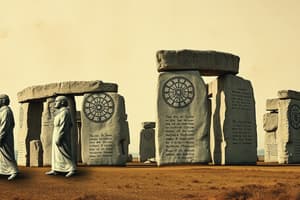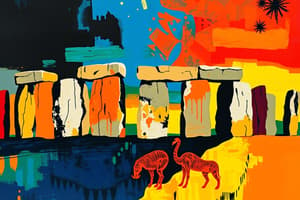Podcast
Questions and Answers
Hammurabi established the first written code of law during his reign.
Hammurabi established the first written code of law during his reign.
True (A)
What was the primary purpose of Stonehenge?
What was the primary purpose of Stonehenge?
- A calendar to mark summer and winter (correct)
- A temple for worship
- A defensive structure
- A burial site
The longest-ruling pharaoh of the time was __________ II, known as the Great.
The longest-ruling pharaoh of the time was __________ II, known as the Great.
Ramses
What type of writing system evolved in southern Mesopotamia around 2600 BC?
What type of writing system evolved in southern Mesopotamia around 2600 BC?
Match the following historical figures or artifacts with their significance:
Match the following historical figures or artifacts with their significance:
Cultures in the ancient Near East (often called the Cradle of Civilization) practiced intensive year-round agriculture, developed a writing system, invented the potter’s wheel, created a centralized government, law codes, and empires, and introduced social stratification, slavery, and organized warfare.
The earliest known writing emerged in southern Mesopotamia around 3400 BC, originating as a system of pictographs that evolved by 2600 BC into the distinctive wedge-shaped script we call "cuneiform."
One of the enlightened rulers of this civilization was Hammurabi (ruled c. 1792-1750 BCE) who established the first written code of law. The Stele of Hammurabi is a vertical stone stele inscribed in cuneiform with an entire set of laws that covered everything from inheritance to murder.
Khafre built the second largest of the Giza pyramids possibly as a monument to himself and possibly as his tomb.
a painting, drawing, photograph, or engraving of a person, especially one depicting only the face or head and shoulders
A sphinx is a mythical creature with the head of a human, the body of a lion, and the wings of an eagle.
King Tut came into power when he was only nine years old and died unexpectedly ten years later at the age of 19.
The longest-ruling pharaoh of the time was Ramses II, the Great, (1304–1237 BC). In his 67 year reign, he ordered the creation of an enormous amount of temples, palaces, sculptures, and wall paintings. His influence is seen everywhere,
Cultures in the ancient Near East (often called the Cradle of Civilization) practiced intensive year-round agriculture, developed a writing system, invented the potter’s wheel, created a centralized government, law codes, and empires, and introduced social stratification, slavery, and organized warfare. The earliest known writing emerged in southern Mesopotamia around 3400 BC, originating as a system of pictographs that evolved by 2600 BC into the distinctive wedge-shaped script we call "cuneiform." One of the enlightened rulers of this civilization was Hammurabi (ruled c. 1792-1750 BCE) who established the first written code of law. The Stele of Hammurabi is a vertical stone stele inscribed in cuneiform with an entire set of laws that covered everything from inheritance to murder. Khafre built the second largest of the Giza pyramids possibly as a monument to himself and possibly as his tomb. a painting, drawing, photograph, or engraving of a person, especially one depicting only the face or head and shoulders
A sphinx is a mythical creature with the head of a human, the body of a lion, and the wings of an eagle. King Tut came into power when he was only nine years old and died unexpectedly ten years later at the age of 19. The longest-ruling pharaoh of the time was Ramses II, the Great, (1304–1237 BC). In his 67 year reign, he ordered the creation of an enormous amount of temples, palaces, sculptures, and wall paintings. His influence is seen everywhere,
Flashcards are hidden until you start studying
Study Notes
Stonehenge and Ancient Civilizations
- Stonehenge is a renowned prehistoric monument, believed to function as a calendar to signal the summer and winter solstices.
- The ancient Near East, known as the Cradle of Civilization, was pivotal in developing year-round agriculture, writing systems, and centralized governance.
- This region is marked by the rise of law codes, empires, social stratification, slavery, and organized warfare.
Writing Development
- The first known writing system appeared in southern Mesopotamia around 3400 BC.
- Initially, it started as pictographs and evolved into cuneiform by 2600 BC, characterized by its distinctive wedge-shaped characters.
Hammurabi and Law
- Hammurabi, an important ruler of ancient Babylon (c. 1792-1750 BCE), is credited with establishing the first written legal code.
- The Stele of Hammurabi is a significant artifact, featuring the cuneiform inscribed laws that address various aspects of society, including inheritance and homicide.
Egyptian Mythology and Pharaohs
- The sphinx, a mythical creature with a human head and a lion's body, symbolizes the solar deity in Egyptian belief, specifically Horemakhet or Horus of the Horizon.
- King Tutankhamun ascended to the throne at the age of nine and reigned until his untimely death at nineteen.
- Ramses II, known as Ramses the Great, ruled for an impressive 67 years (1304–1237 BC), during which he commissioned the construction of numerous temples, palaces, and monumental artworks.
Studying That Suits You
Use AI to generate personalized quizzes and flashcards to suit your learning preferences.




